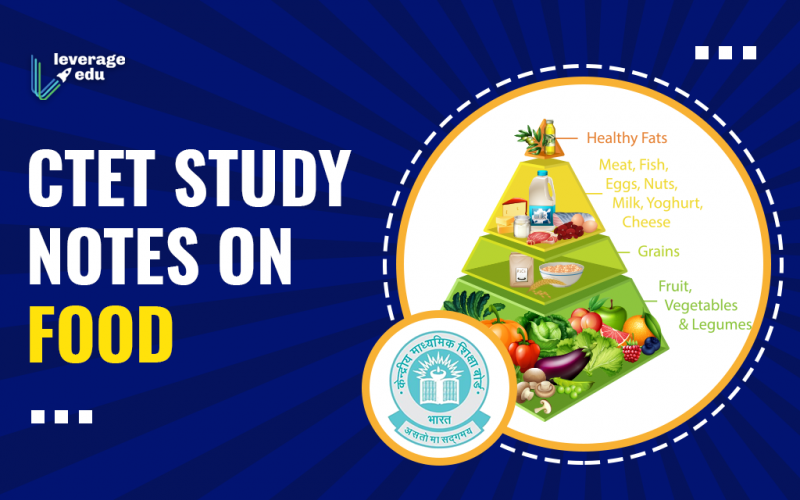Studying for CTET can be a tough job especially with its expansive syllabus 410 and lengthy exams! CTET is a national-level exam conducted by the Central Board of Secondary Education. The Central Teacher Eligibility Test (CTET) is conducted twice a year to know the eligibility for appointment as teachers for Classes 1 to 8. With so much of the syllabus to cover, we are here to make your life a little simpler. So, here are the CTET Study Notes on Food.
Also Read: CTET Child Development Theories
This Blog Includes:
What is Food?
In our CTET study notes on food, we will cover the definition of food, so, what is food? Foods are substances that are important for the growth of an organism. There are some organisms such as plants that make their own food by the process of photosynthesis. On the other hand, animals obtain their food from plants and other animals.
What is Nutrition?
According to CTET study notes on food, the process of obtaining nutrients is called nutrition. Nutrients can be organic or inorganic substances that help in maintaining proper health. Body nutrients are classified into two categories:
- Macro Nutrients: These are required by the body in large amounts. E.g. carbohydrates, fat, and protein.
- Micro Nutrients: These are required in a very small amount. e.g., minerals and vitamins. Micronutrients help to regulate different functions of the body.
Explore: Child Development and Pedagogy Notes 410
Components of Foods
In our CTET study notes on food, we will cover the different components of food. There are five main components- Carbohydrates, Fats, Proteins, Water, Minerals, Roughage and Vitamins.
Carbohydrates
They provide energy to organisms and are the primary source of energy to all living beings on the Earth. These are the cheapest sources of energy.
Common Sources of Carbohydrates:
- Starch: Cereals (wheat, rice, and maize), millets (bajra, jowar, barley roots, and tubers (sweet potato, tapioca, and potato).
- Sugar: Sugarcane, beetroot, fruits (banana, mango, sapota, or chiku), milk, honey etc.
- Cellulose is a fibrous substance that is not digested by the human body. However, it serves as roughage.
Functions of Carbohydrates
- Lactose sugar promotes the growth of intestinal bacteria that facilitate the absorption of calcium.
- Excess carbohydrates are converted into glycogen and serve as reserve sources of energy.
- Glucose is the only source of energy for the central nervous system.
Fats
Fats are members of the lipid family that are insoluble in water but soluble in an organic solvent.
- They are the richest source of energy but not the primary source of energy.
- Fats are obtained from ghee, butter, oil, meat, cheese, milk, cakes, cream, etc.
- Fats are stored in the body and act as an insulator to cold weather and any external shock.
Proteins
Proteins are made up of many amino acids. Amino acids are of two types
- Essential Amino Acid: These amino acids are not synthesized in the human body so it is very important to take them from outside in the form of food.
- Non-Essential Amino Acid: These amino acids are synthesized in the animal body.
Proteins can be obtained from pulses, legumes, nuts, milk, fish, liver, egg, cheese, etc.
Protein performs many functions:
- Proteins are the structural component of the body and are required in building and maintaining body tissues.
- Enzymes are made up of protein and these enzymes help in digestion so protein plays a role in digestion.
- Protein also plays an important role in transporting oxygen in the blood.
Also Read: CTET Study Notes on Health and Diseases 410
Vitamins
According to CTET study notes on food, Vitamins are chemical substances required by the body in very small amounts. They are essential for proper metabolic functions of the body, good health of the body, and protect the body from various diseases.
| Vitamin | Functions | Best and Sources |
| Vitamin B1 | Carbohydrate metabolism; sharpens appetite; the functioning of the heart, nerves, and muscles. | Yeast; liver, milk; cheese; leafy vegetables, meat; whole-grain cereals. |
| Vitamin B2 | Carbohydrate and protein metabolism; keeps skin healthy. | Milk, liver meat: eggs, peas, yeast; whole grains; green leafy vegetables. |
| Vitamin B3 | Protein, fat, and carbohydrate metabolism. Keeps the skin healthy. | Fish; eggs; meat; legumes; whole grains; leafy vegetables, peanuts; bean; tomato: potato. |
| Vitamin B12 | Blood formation, Nervous tissue metabolism, Nucleic acid synthesis. | Liver; fish; cheese; milk, eggs, meat. |
| Vitamin C | Resistance to infections; keeping teeth, gums, and joints healthy. | Amia, cabbage; tomatoes, lemon, orange; mangoes; chillies, guava, pineapple; sprouted grams. |
| Vitamin A | Maintenance of vision and skin; essential for the synthesis of visual pigment. | Milk, cheese, butter, eggs, olive oil, carrots, mangoes, papaya, yellow pumpkin, spinach, and sweet potato. |
| Vitamin D | Keep teeth and bones healthy, absorption of calcium and phosphorus. | Mild, cheese; egg yolk; fish, fish butter; exposure to sunlight. |
Also Read: CTET Notes on Learning Principles and Theories
Minerals
These are micro-nutrient that help in the proper functioning and growth of the body. Minerals are the inorganic component that helps proteins in performing normal functions. According to CTET study notes on food, Minerals are categorized into two classes: major elements and minor elements on the basis of their daily requirements. Examples of major elements are calcium, phosphorus, potassium, sodium, chlorine, and iron. Examples of minor elements are iodine, magnesium, cobalt, etc.
Minerals: Sources and Importance
| Minerals | Sources | Importance |
| Iron | Green vegetables like amla, spinach, apple, wheat, jaggery, grains, turnip, meat, eggs. | Formation of haemoglobin |
| Calcium | Green vegetables, milk and milk products, eggs. | For strong bones and teeth |
| Phosphorous | Eggs, meat, fish, whole, grains, milk | For strong bones and teeth |
| Iodine | Seafood and iodized salt | For proper functioning of the thyroid gland |
| Sodium | Table salt, vegetables, processed food | Maintain proper fluid balance, nerve transmission, and muscle contraction |
| Potassium | Milk, meat, vegetables, fruits | Maintain fluid balance, nerve transmission, and muscle contraction |
| Magnesium | Vegetables, legumes, nuts, and seeds | Found in bones, important for muscle contraction, the importance for protein functioning |
Related Read: CTET Social Science
Roughage
According to CTET study notes on food, Roughage is the fibre present in some food items like fruits and vegetables. Though roughage is not a food, it forms an important part of our diet. Some functions of roughage are
- It helps in bowel movement.
- It cleans our digestive tracts and protects us from digestive ailments.
- It helps in retaining water in the body.
- It helps in maintaining optimum levels of blood sugar and cholesterol.
Also Read: CTET Notes on First Farmers and Herders
Water
According to CTET study notes on food, water is an important constituent of our diet. 75% of an infant’s body and 70% of an adult’s body is nothing but water. Various functions of water are as follows
- Essential for the transport and digestion of food material.
- Excretes waste.
- Maintains the body temperature.
- Acts as a solvent in various reactions in the body.
Balanced Diet
According to CTET study notes on food, a balanced diet is one that contains all essential nutrients in suitable proportion to provide necessary energy and to keep the body in a healthy state. A balanced diet has the following qualities
- It meets the nutrient requirement of the body.
- It consists of different types of food items.
- It provides an adequate amount of energy.
Must Read: CTET Notes on Family
FAQs
Food is any substance consumed by living organisms to provide them with the necessary nutrients, energy, and sustenance for growth, maintenance, and overall well-being. It is typically of plant or animal origin and contains a variety of macronutrients (such as carbohydrates, proteins, and fats), micronutrients (such as vitamins and minerals), and other essential components.
Carbohydrates, Roughage, Water, Materials, and Vitamins are some of the important topics of CTET.
Roughage, also known as dietary fibre or bulk, refers to the indigestible portion of plant-based foods. It includes the structural components of plants such as cellulose, hemicellulose, and lignin, as well as non-starch polysaccharides, resistant starch, and other substances that cannot be broken down by human digestive enzymes.
This was all about CTET study notes on food! We hope that this helps you to crack the exam. For any queries or doubts, feel free to comment below or call our experts at 1800572000. Follow Leverage Edu on Facebook, Youtube, Instagram and LinkedIn.

 One app for all your study abroad needs
One app for all your study abroad needs




























 45,000+ students trusted us with their dreams. Take the first step today!
45,000+ students trusted us with their dreams. Take the first step today!


